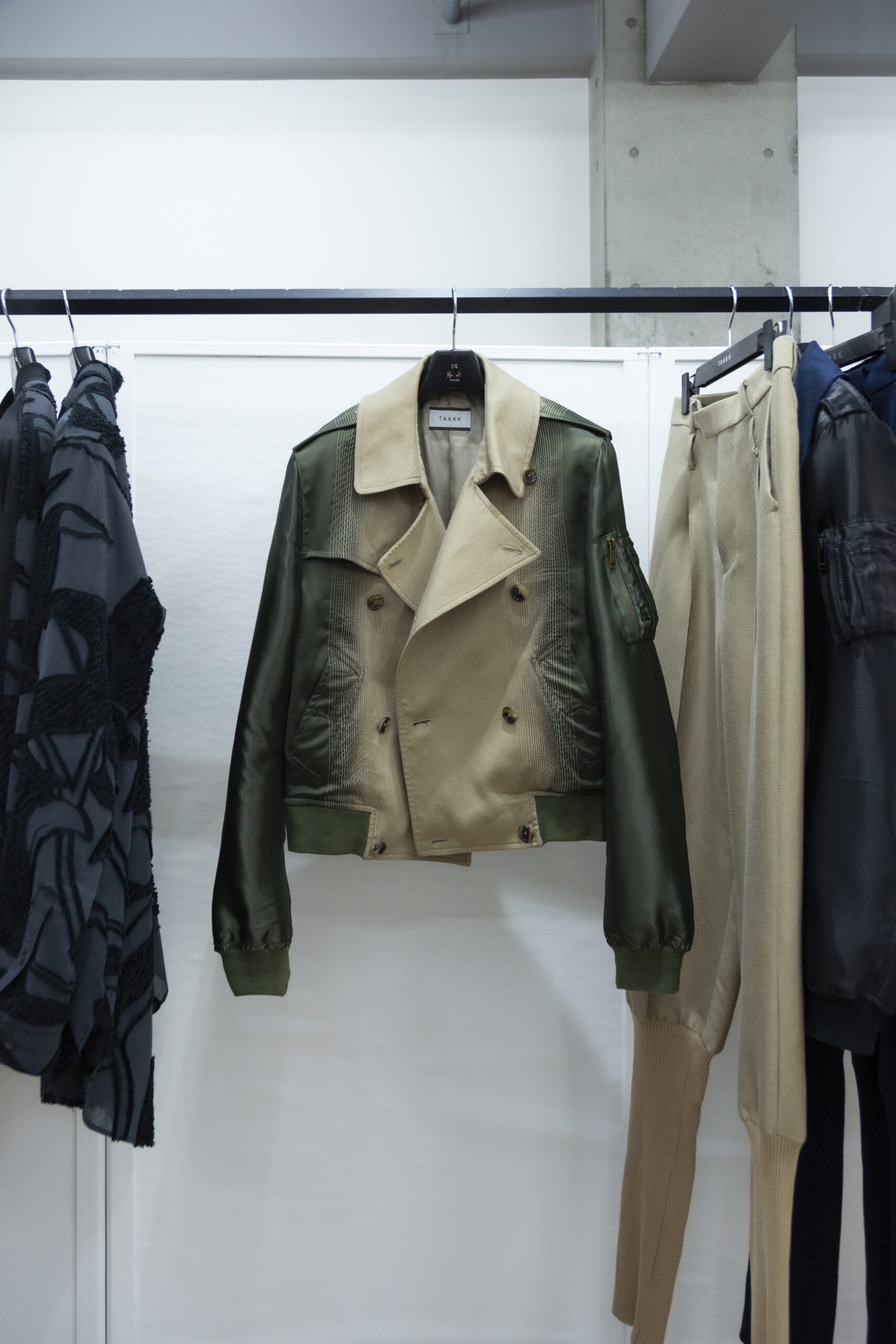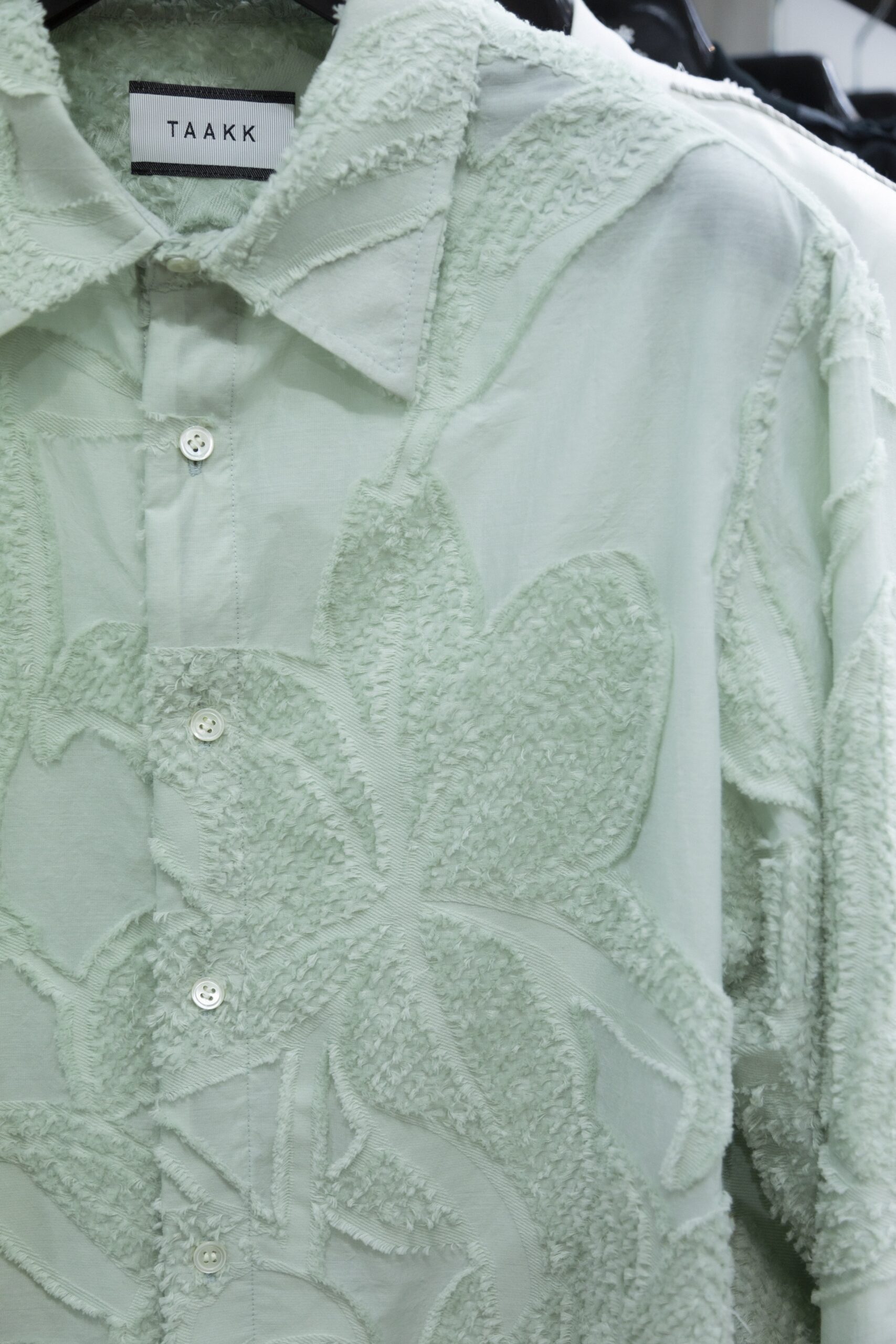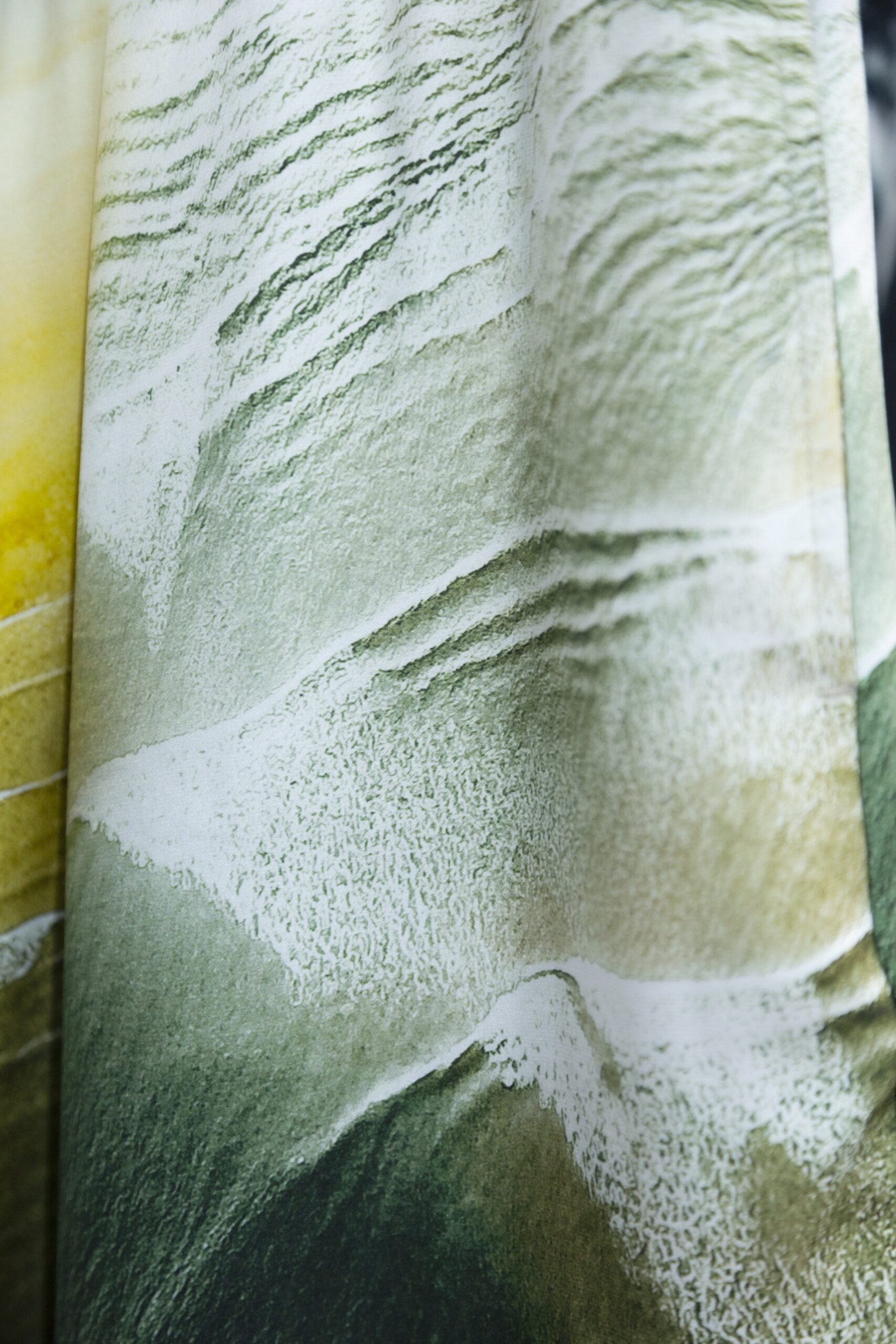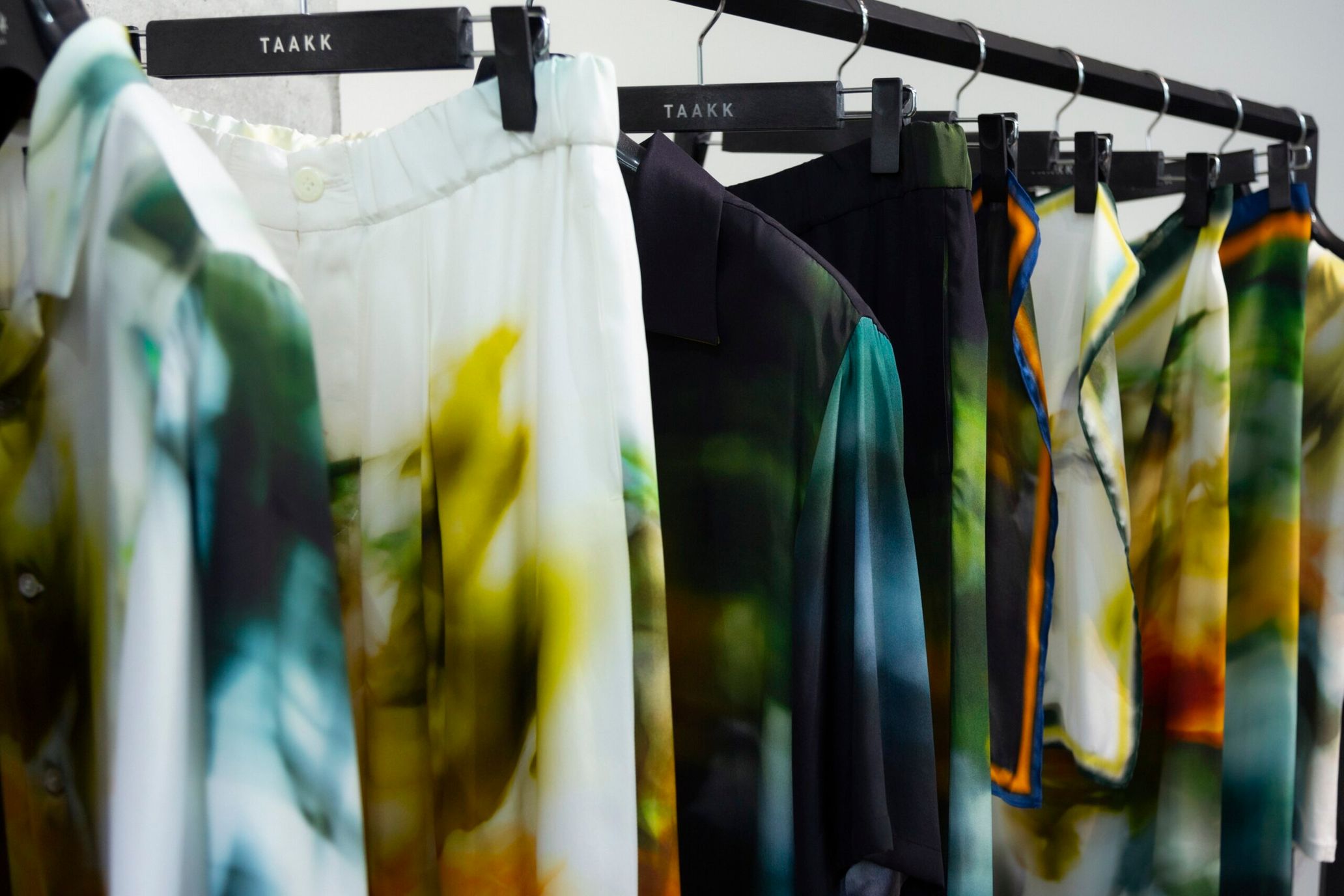There’s something off-kilter about Takuya Morikawa’s brand, TAAKK. Most of the brand’s clothes are closet staples, such as tailored jackets, shirts, trench coats, and bomber jackets. But upon a closer look, one could notice that something is different.
Not only does TAAKK offer quality clothes, but the brand also creates never-before-seen items by developing original fabrics, which are the foundation and the source of design inspiration. By utilizing a material that changes, making it look like a gradation, the boundary between a jacket and shirt blurs, and two become one. And by distressing denim through weaving, as opposed to adding the effect in a manufactured way, a classic clothing item could reveal a new side. TAAKK’s trait is that while the fabric and clothes, made with top-tier technology, have an off-kilter air, one could easily incorporate them into their wardrobe.
This two-part interview digs into TAAKK’s philosophy behind making clothes, highlighting the brand’s fabrics. In part two, Morikawa spoke to us about some spring/summer 2022 pieces and the power of clothes.
Mixing fabrics with gimmicks and elevated design
–Within your latest collection, I was especially surprised by the series of clothes with gradating fabrics. The clothes, such as trench coats and bomber jackets, transform because the fabrics shift from one to another. What aspect did you focus on and update?
Takuya Morikawa (Morikawa): Because this series is still freshly new, we had so much fun when we made the first one. We tested out different materials for the following collection, but this time around, my covert aim was to bring out a thickness and roundness to the clothes. Until recently, we used single weave fabrics, but we used double weave fabrics to add some volume this time.
–You sought to create high-quality fabrics instead of just having an idea in mind.
Morikawa: I didn’t know to what extent I could update them at first. But I finally started to get an understanding by working with a weaver to create prototypes. For the first year since the outbreak of covid, we raised the standard of our staple items by pouring energy into technological development instead of just artistic expression.
–The flower embroidery that aligns with the gradated fabrics caught my eye, too.
Morikawa: We added this embroidery of growing cherry blossom branches to match the fabric gradation. I wanted to create an elevated feel with this design, aside from the technical surprise of the fabric. The overarching objective was about how to add artistic expression to the techniques we had developed during covid.
–This linen jacket changes into a cotton shirt toward the hem and can be tucked in. In past interviews, you’ve said that you first look at a finished fabric and consider how it could take form. I feel like you made this in that exact way.
Morikawa: The more differences there are in the materials, the easier it is to create contrasts with the shape. I try to make clothes that match the fabric’s characteristics. It’s like, I don’t force the design, but create the form that each material demands instead.
–What other fabrics do you have?
Morikawa: This clothing item with a lily motif is what’s called cut jacquard, commonly seen in womenswear. I like how the large patterns contrast with the relaxed fit. With jacquard fabrics, the size you could make is limited, and not many machines could make them this big. But this product was made possible because I knew a place that could produce it.
–Do you also make clothes from manipulated ready-made fabrics?
Morikawa: Yes, but we add different treatments to transform them into never-before-seen fabrics. We use a burnout technique, which dissolves cotton, for fabrics that anyone who makes clothes could purchase easily. Then, we add pigments to create a contrast (between the translucent and pigmented part), resulting in a fabric no one’s made before.
–Even a fabric we’ve all seen before could transform by how you present it.
Morikawa: We manipulated an already-existing fabric for this. When an artisan makes clothes from a polyester jersey material that’s commonly used in healthcare and then sprays on top of it, they create an uneven texture because they’re human. That’s what makes the fabric look like leather. This fabric wasn’t supposed to be for fashion, but I choose fabrics that suit different treatments.
–Do factories understand such bold ideas right away?
Morikawa: If we know in advance what each factory can do, we can make suggestions like, “If we do it this way, we can make so-and-so” because we also have the experience. It’s fun to think about the logic behind fabric production.
Aiming to create clothes that marry the beauty of nature and technology
–What feelings did you pour into the theme of your latest collection, nature?
Morikawa: I wanted to go with a happy theme because I thought by the time I presented this collection, covid would be over, and I could go to Paris. Nature is something everyone likes, and I felt drawn to the power of nature. Since everyone’s constantly collaborating, I decided to “collaborate” with the earth as though it were an artist (laughs).
–You utilized images of the earth and the coastline made by waves.
Morikawa: We humans can’t draw this formative beauty even if we wanted to, and it has an uncalculated beauty. I wanted to integrate the image with the technology instead of just printing it. I used the word “collaboration” because I wanted to create a garment that mixed the beauty of nature with technology.
–This also seems like the scenery’s gradually melting away into nothingness via gradation. How did you make it?
Morikawa: The fabric changes from a non-translucent white to a translucent black. When you print a pattern on it, it shows on the non-translucent white but not on the translucent black. That’s why the pattern looks like it’s gradually fading away.
–What a great idea!
Morikawa: For people who make clothes, it’s common knowledge that inkjet prints don’t show on a black background, so my idea uses that. But it’s difficult to print and cut the graphic to fit the pattern of the garment.
–The tie-dye print also had a strong punch.
Morikawa: If you drip paint on water, it spreads beautifully. I pictured that and made this graphic because I thought it’d look lovely if a flower dissolved in water. So, upon first glance, you might not be able to tell what it is, but it originated from a flower.
The magic of clothes, and the duty of a designer
–You showed your collection through a video this season. I was impressed when you said that your mission as a designer is to make the person wearing your clothes happy for the day.
Morikawa: I think that’s the most important job of a designer. You know how you feel awful when you spend the day in a shirt that doesn’t match your mood? It makes you not want to see people. But on days you wear your favorite clothes, you feel so happy. That’s the power of clothes. It’s the designer’s mission to make clothes like that with everything they got.
–Often, we wear what we think is genuinely cool without putting too much thought into it. But when I see clothes that surprise me, it reminds me that fashion is fun, fundamentally. Your brand, TAAKK, makes clothes like that.
Morikawa: I want to respond to that, and I believe our clothes convey something to the person wearing them. I often say, “I design without designing.” While I do design to bring forth a strong individuality as a brand, I prioritize making clothes that correspond to the wearer’s lifestyle. Sometimes people call surface-level cutting and pasting “fashion design,” but you can’t convey anything if it’s superficial. I want to show how strong the core of my brand is.
–You can say the design of fabrics is foundational, as they touch the skin.
Morikawa: Clothes are a culmination of different elements. People should start designing from the most fundamental part: the fabric. Three-star chefs utilize vegetables from contract farmers, not from supermarkets. They choose vegetables that fit their dish, communicate with the producers, and take time to create something that moves the customer. Fashion is the same. That’s why I study threads, try to understand everything about looms, and go in and talk to artisans about what I’m searching for. I keep on doing what I should be doing.
Photography Kohei Omachi
Translation Lena Grace Suda















